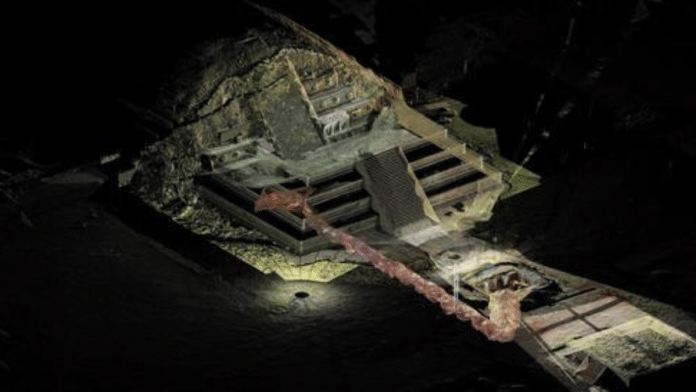Thank you dear subscribers, we are overwhelmed with your response.
Your Turn is a unique section from ThePrint featuring points of view from its subscribers. If you are a subscriber, have a point of view, please send it to us. If not, do subscribe here: https://theprint.in/subscribe/
Was Mercury the propellent in the Flying Vimanas, the flying temples of my ancestral forefather, Maharishi Bhardwaj? Was this found in the Ancient Teotihuacan King’s Tomb in Mexico?
Exploring the intricate tapestry of human history often reveals surprising connections between seemingly disparate cultures. One such intriguing link is the potential connection between the Tamil and Telugu cultures of South India and the ancient civilizations of South America. This essay delves into the linguistic, cultural, genetic, and geological threads that weave these distant regions together, drawing on recent research and historical narratives.
The Dravidian languages, including Tamil and Telugu, have a rich history dating back thousands of years. These languages, primarily spoken in southern India, boast long literary traditions. Interestingly, some researchers have noted similarities between the Dravidian languages and certain indigenous languages of South America. For example, structural and phonetic resemblances between Tamil and the Quechua language of the Andes have sparked debates among linguists about possible ancient connections.
Cultural parallels also abound. The architectural styles of ancient South Indian temples and the pyramids of Mesoamerica share striking similarities. Both regions exhibit a penchant for intricate stone carvings and monumental structures that align with celestial bodies. The motifs and symbols found in South Indian art, such as the serpent and the lotus, also appear in the iconography of pre-Columbian civilizations like the Maya and the Aztecs.
The genetic history of the indigenous peoples of the Americas is complex and multifaceted, where genetic analysis has identified a specific genetic signature, known as the “Y signal,” linking some South American tribes to populations in South Asia, including India. This genetic marker, found in both ancient and modern indigenous people in the Amazon, indicates a shared ancestry with groups from South Asia, Australia, and Melanesia. The presence of this marker supports the theory of ancient maritime migrations connecting these distant regions.
Recent geological studies have unveiled fascinating insights into the ancient connections between Andhra Pradesh and various continents, including South America, Africa, Australia, and Antarctica. Scientists from the National Geophysical Research Institute (NGRI) in Hyderabad discovered evidence of a historic collision between the Indian subcontinent and East Antarctica over a billion years ago, leaving significant geological features such as a hidden ridge beneath the Darsi and Addanki regions of Andhra Pradesh.
The research highlights the presence of Proterozoic sediment layers in the region, dating back to the time when the supercontinent Gondwana existed. Gondwana included present-day South America, Africa, Arabia, Madagascar, India, Australia, and Antarctica. The geological formations in Andhra Pradesh, particularly the Cuddapah basin, provide crucial evidence of these ancient connections.
Adding another layer to this intricate web of connections is the linguistic overlap between Quechua and Sanskrit. Scholars have identified several words in Quechua that bear striking similarities to Sanskrit terms. For example, the Quechua word “santiya,” meaning “to rest,” is derived from the Sanskrit word “shanti,” which means “peace.” Such linguistic parallels suggest a deeper historical connection and possible cultural exchanges between these ancient civilizations.
The Vedic texts, particularly those attributed to my forefather Maharishi Bhardwaj, describe ancient flying machines known as Vimanas. These texts mention the use of mercury as a crucial component in the propulsion systems of these Vimanas. The mercury engine, with its iron heating apparatus, was believed to generate a powerful whirlwind, enabling the Vimana to travel great distances in the sky.
Interestingly, a similar use of mercury has been discovered in the ancient city of Teotihuacan in Mexico. Archaeologists found large quantities of liquid mercury in a chamber beneath the Pyramid of the Feathered Serpent. This discovery has led researchers to speculate that the mercury might have been used to symbolize an underworld river or lake, possibly indicating the presence of a royal tomb. The use of mercury in both Vedic and Mesoamerican contexts suggests a shared technological or symbolic significance, further supporting the idea of ancient trans-oceanic connections.
The geological and genetic evidence together paint a picture of a world where ancient civilizations were far more interconnected than previously thought. The Tamil and Telugu people, with their rich maritime history, could have been part of these ancient migrations, contributing to the cultural and genetic tapestry of South America. This interconnectedness challenges our conventional understanding of human history and underscores the importance of interdisciplinary research in uncovering the complexities of our past.
This exploration not only highlights the interconnectedness of ancient cultures but also fosters a deeper appreciation for the shared heritage that unites us all.
These pieces are being published as they have been received – they have not been edited/fact-checked by ThePrint


